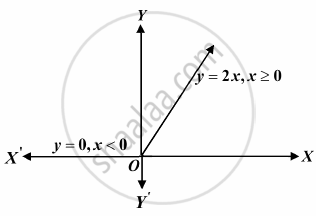Advertisements
Advertisements
Question
The set of all points where the function f(x) = x + |x| is differentiable, is ______.
Options
(0, ∞)
(–∞, 0)
(–∞, 0) ∪ (0, ∞)
(–∞, ∞)
Solution 1
The set of all points where the function f(x) = x + |x| is differentiable, is (–∞, 0) ∪ (0, ∞).
Explanation:
f(x) = x + |x| = `{{:(2x",", x ≥ 0),(0",", x < 0):}`

There is a sharp corner at x = 0, so f(x) is not differentiable at x = 0.
Solution 2
The set of all points where the function f(x) = x + |x| is differentiable, is (–∞, 0) ∪ (0, ∞).
Explanation:
Lf' (0) = 0 and Rf' (0) = 2 ; so, the function is not differentiable at x = 0
For x ≥ 0, f(x) = 2x (linear function) and when x < 0, f(x) = 0 (constant function)
Hence f(x) is differentiable when x ∈ (–∞, 0) ∪ (0, ∞).
APPEARS IN
RELATED QUESTIONS
Differentiate the function with respect to x.
`cos x^3. sin^2 (x^5)`
Differentiate the function with respect to x.
`2sqrt(cot(x^2))`
Differentiate w.r.t. x the function:
sin3 x + cos6 x
Differentiate w.r.t. x the function:
`(cos^(-1) x/2)/sqrt(2x+7), -2 < x < 2`
Find `dy/dx, if y = 12 (1 – cos t), x = 10 (t – sin t), -pi/2< t< pi/2`
If (x – a)2 + (y – b)2 = c2, for some c > 0, prove that `[1+ (dy/dx)^2]^(3/2)/((d^2y)/dx^2)` is a constant independent of a and b.
If f (x) = |x|3, show that f ″(x) exists for all real x and find it.
If f(x) = x + 1, find `d/dx (fof) (x)`
If y = tan(x + y), find `("d"y)/("d"x)`
If y = tanx + secx, prove that `("d"^2y)/("d"x^2) = cosx/(1 - sinx)^2`
Let f(x)= |cosx|. Then, ______.
Differential coefficient of sec (tan–1x) w.r.t. x is ______.
If u = `sin^-1 ((2x)/(1 + x^2))` and v = `tan^-1 ((2x)/(1 - x^2))`, then `"du"/"dv"` is ______.
cos |x| is differentiable everywhere.
`cos(tan sqrt(x + 1))`
`sin^-1 1/sqrt(x + 1)`
`tan^-1 ((sqrt(1 + x^2) + sqrt(1 - x^2))/(sqrt(1 + x^2) - sqrt(1 - x^2))), -1 < x < 1, x ≠ 0`
If xm . yn = (x + y)m+n, prove that `("d"^2"y")/("dx"^2)` = 0
For the curve `sqrt(x) + sqrt(y)` = 1, `"dy"/"dx"` at `(1/4, 1/4)` is ______.
The differential coefficient of `"tan"^-1 ((sqrt(1 + "x") - sqrt (1 - "x"))/(sqrt (1+ "x") + sqrt (1 - "x")))` is ____________.
A function is said to be continuous for x ∈ R, if ____________.
`d/(dx)[sin^-1(xsqrt(1 - x) - sqrt(x)sqrt(1 - x^2))]` is equal to
If sin y = x sin (a + y), then value of dy/dx is
A particle is moving on a line, where its position S in meters is a function of time t in seconds given by S = t3 + at2 + bt + c where a, b, c are constant. It is known that at t = 1 seconds, the position of the particle is given by S = 7 m. Velocity is 7 m/s and acceleration is 12 m/s2. The values of a, b, c are ______.
If f(x) = `{{:(ax + b; 0 < x ≤ 1),(2x^2 - x; 1 < x < 2):}` is a differentiable function in (0, 2), then find the values of a and b.
The function f(x) = x | x |, x ∈ R is differentiable ______.
If f(x) = | cos x |, then `f((3π)/4)` is ______.
